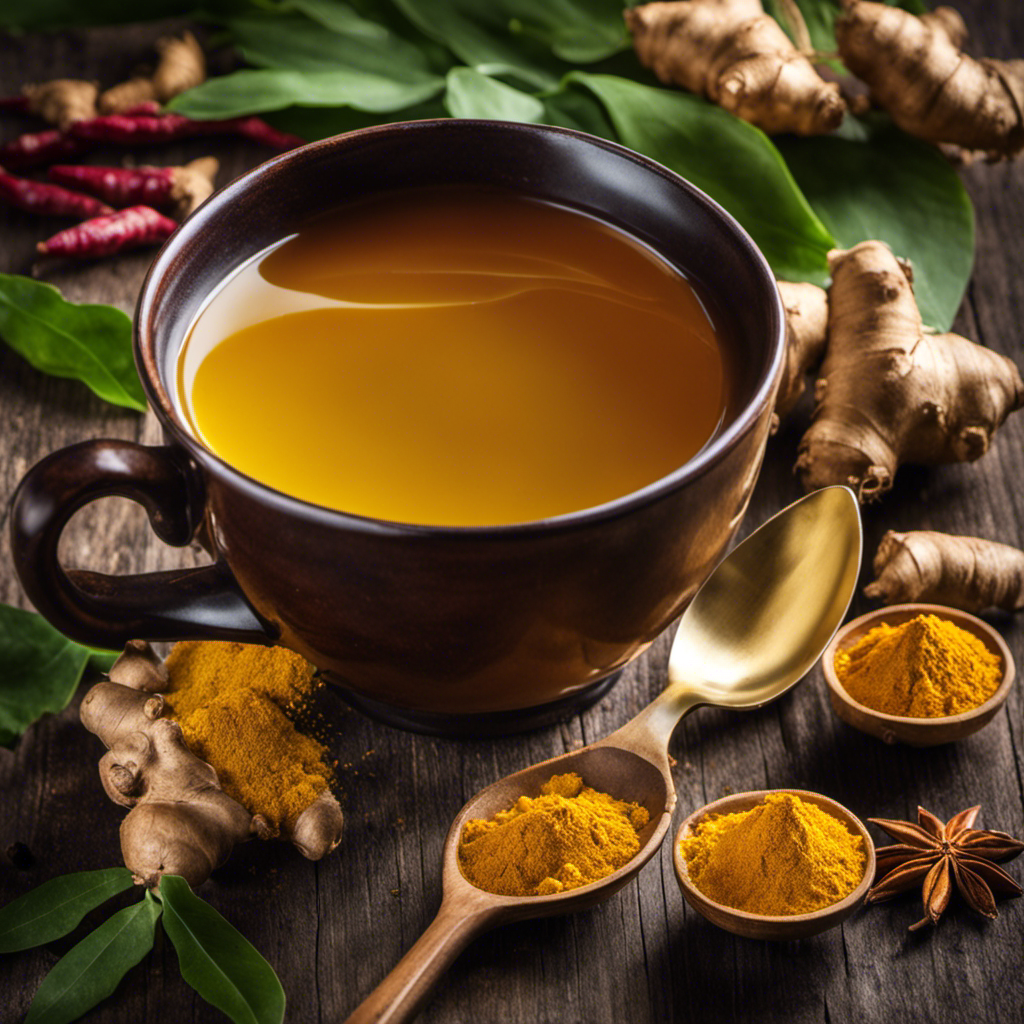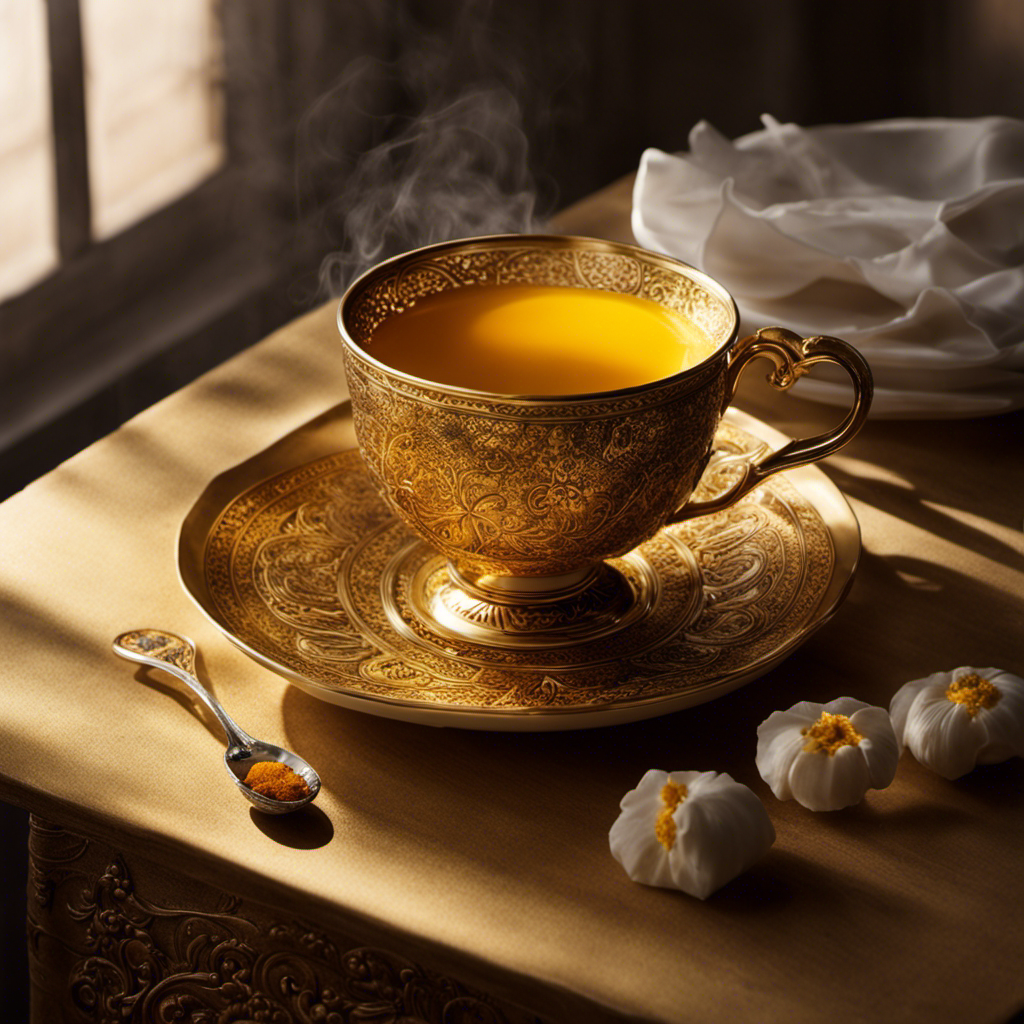Matcha
Matcha for Skin Care: Glowing Complexion Secrets
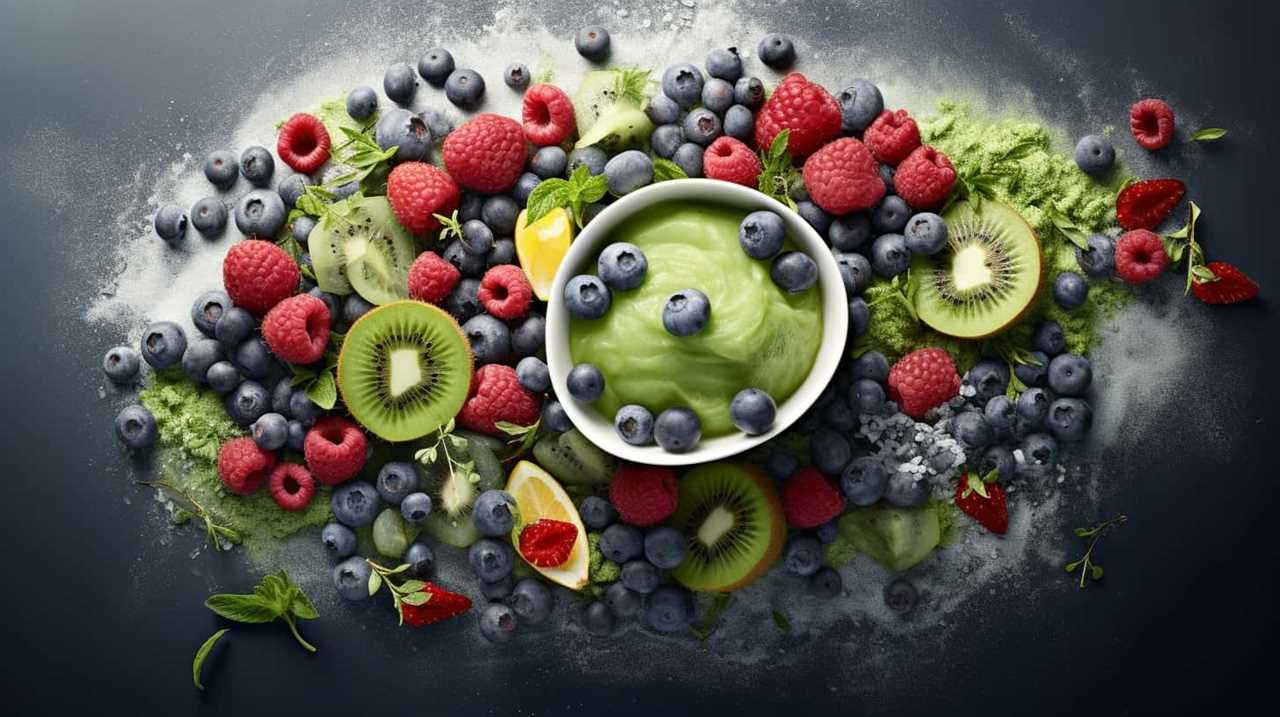
Are you tired of searching for the ultimate solution to flawless skin? Look no further! We have discovered the holy grail of skin care: matcha.
Yes, you heard it right, matcha. This vibrant green powder is not just your average tea; it holds the power to transform your skin and elevate your beauty routine to new heights.
With its incredible antioxidant properties and ability to fight signs of aging, matcha is a game-changer in the world of skin care. Say goodbye to blemishes, inflammation, and sun damage, because matcha is here to save the day.
So, get ready to unlock the secrets of matcha and unleash your skin’s true potential.

Key Takeaways
- Matcha is rich in antioxidants, vitamins, and minerals that promote skin health.
- Matcha’s antioxidants protect the skin against free radicals and reduce signs of aging.
- Matcha provides hydration benefits and improves the skin’s natural barrier function.
- Matcha has anti-inflammatory properties that soothe irritated skin.
The Origins of Matcha
Matcha, a powdered green tea, originates from Japan and has been an integral part of Japanese culture for centuries.
The origins of matcha can be traced back to the Tang Dynasty in China, where powdered tea was first introduced. However, it was the Japanese who perfected the art of growing, processing, and preparing matcha, turning it into a revered beverage and a symbol of Japanese hospitality.
Matcha cultivation involves shading the tea plants for several weeks before harvest, which increases chlorophyll production and gives matcha its vibrant green color. The leaves are then carefully picked, steamed, dried, and ground into a fine powder using traditional stone mills.
This meticulous process ensures that matcha retains its rich flavor, vibrant color, and numerous health benefits.

Today, matcha continues to hold great cultural significance in Japan and is celebrated in traditional tea ceremonies, where its preparation and consumption are regarded as an art form.
Understanding the Nutritional Composition
Let’s take a closer look at the nutritional composition of matcha and how it can benefit our skin.
Matcha is rich in key nutrients such as antioxidants, vitamins, and minerals that promote skin health and combat signs of aging. These nutrients help to protect our skin from environmental damage, improve elasticity, and maintain a youthful appearance.
Incorporating matcha into our skincare routine can be as simple as using matcha-infused products or making our own DIY face masks and scrubs.
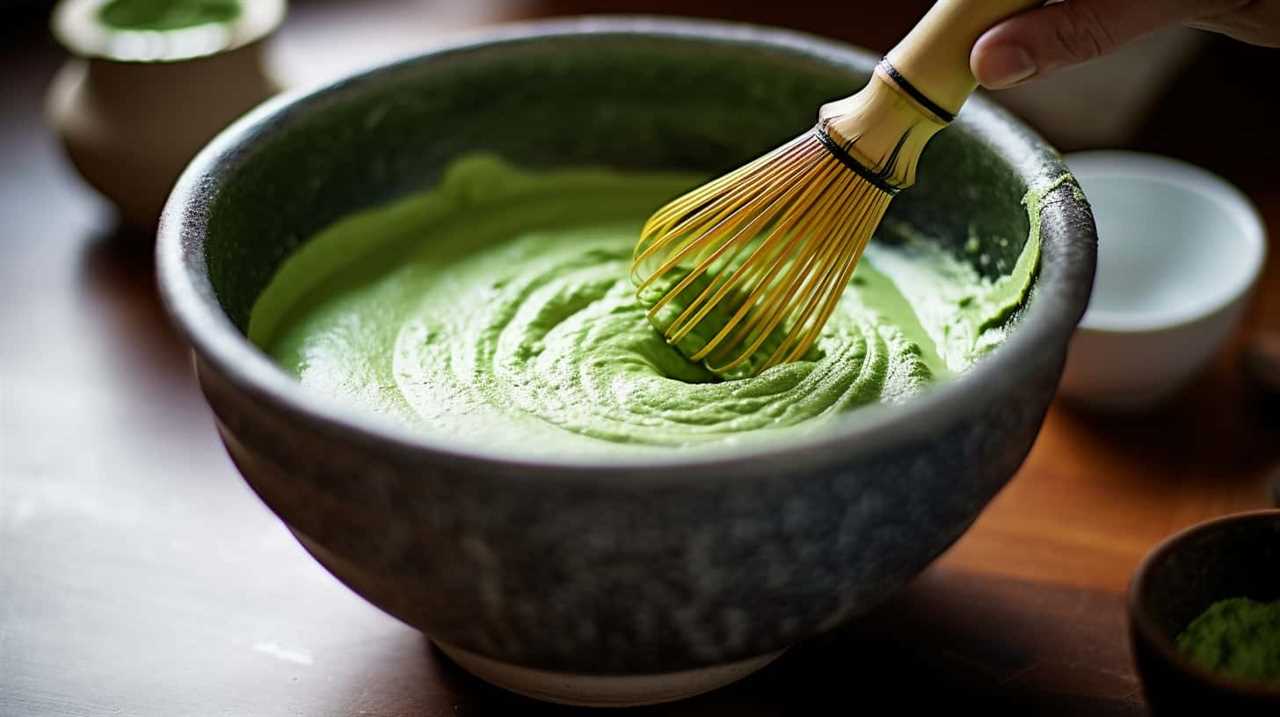
Key Nutrients in Matcha
Understanding the nutritional composition of matcha involves identifying key nutrients that contribute to its skin care benefits.
Matcha is rich in antioxidants, particularly catechins, which help protect the skin against free radicals and reduce the signs of aging.
Additionally, matcha contains chlorophyll, a powerful detoxifier that can help improve skin complexion and reduce acne.
Matcha also contains vitamins A and C, which promote collagen production and help maintain skin elasticity.
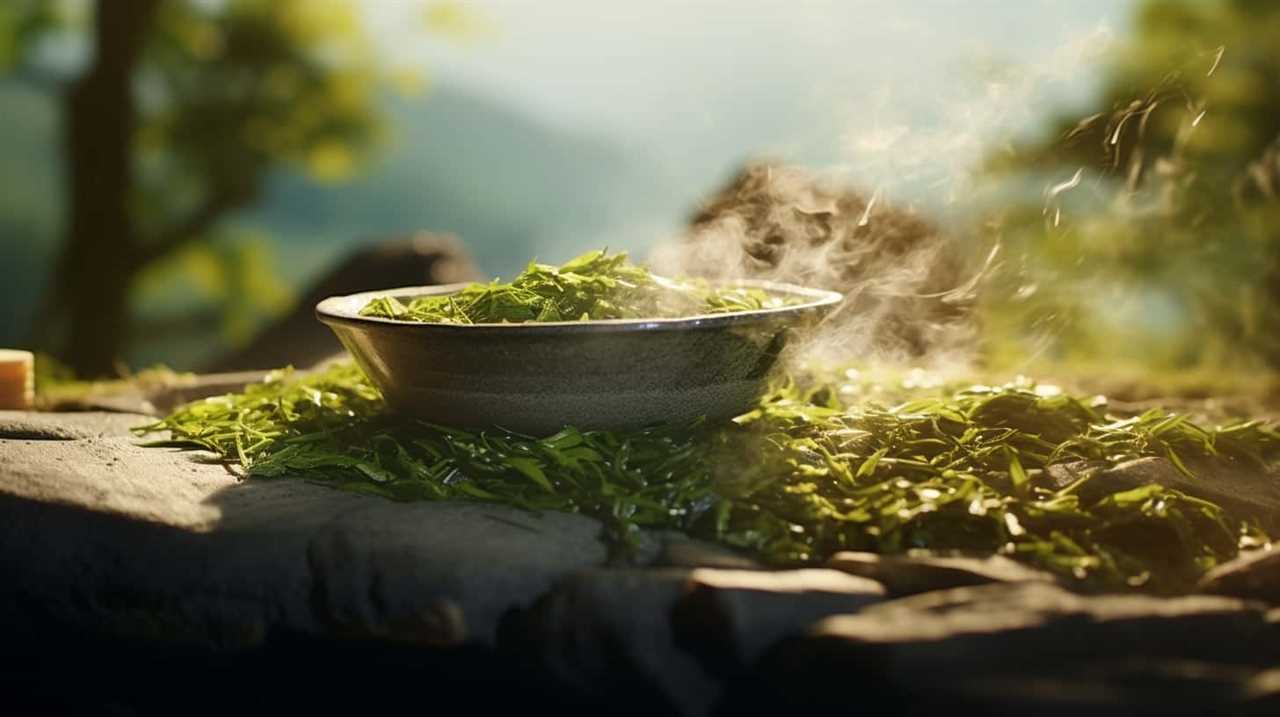
Another important nutrient found in matcha is fiber, which aids in digestion and can contribute to weight loss by promoting a feeling of fullness.
Matcha’s high levels of L-theanine also help to improve focus and reduce stress, which can indirectly benefit the skin by reducing inflammation and preventing breakouts.
Benefits for Skin
As we delve into the benefits for skin, it’s important to consider the nutritional composition of matcha and how it contributes to healthier skin.
Matcha is rich in antioxidants, specifically catechins, which help to protect the skin against free radicals and environmental damage. These antioxidants have anti-aging benefits, as they can reduce the appearance of fine lines and wrinkles, and promote a more youthful complexion.
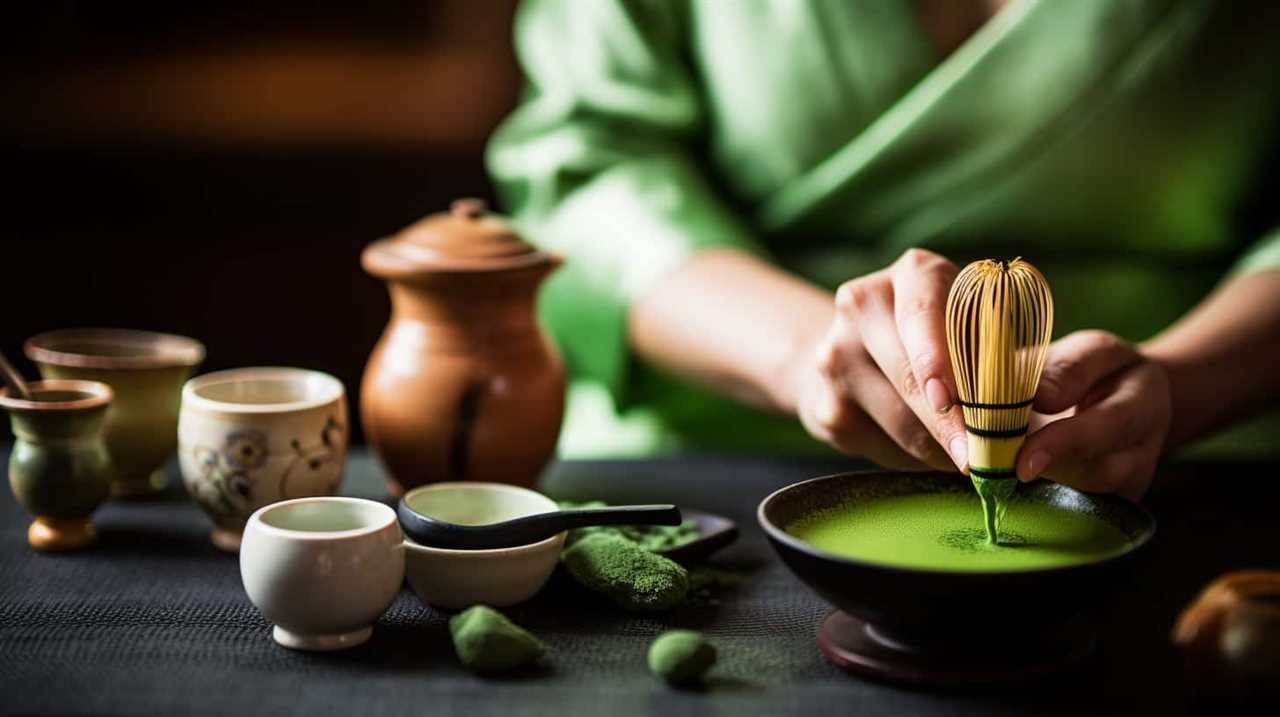
Additionally, matcha contains chlorophyll, which has been found to help detoxify the skin and reduce inflammation.
Matcha also provides skin hydration benefits, as it’s packed with amino acids that help to retain moisture and improve the skin’s natural barrier function.
How to Incorporate
To incorporate matcha into our skincare routine and understand its nutritional composition, we can start by exploring its benefits for our skin. Matcha has become increasingly popular in the beauty industry, with many skincare brands incorporating it into their products. Matcha infused skincare products offer a range of benefits, including antioxidant properties that help protect the skin against free radicals and environmental damage. Additionally, matcha contains chlorophyll, which helps to detoxify the skin and promote a healthy complexion. It also has anti-inflammatory properties that can reduce redness and soothe irritated skin.
To help you understand the nutritional composition of matcha, here is a table showcasing its key components:
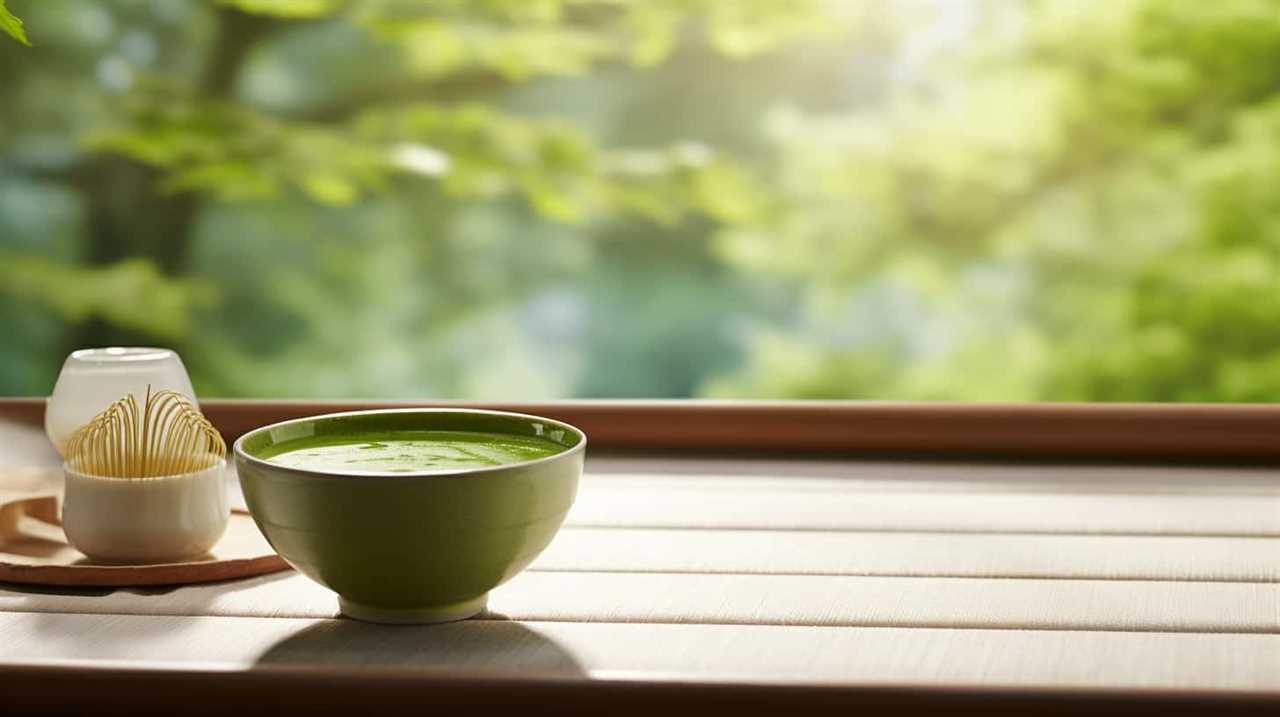
| Nutrient | Amount per 100g |
|---|---|
| Catechins | 105 mg |
| Vitamins (A, C) | 3.2 mg |
| Minerals (Zinc) | 0.5 mg |
| Amino Acids | 3.2 g |
| Fiber | 4 g |
Matcha as an Antioxidant Powerhouse
We harness the antioxidant power of matcha for our skin care routine. Matcha, a powdered form of green tea, is packed with antioxidants that help protect our skin from free radicals and oxidative stress.
Here are three ways we can incorporate matcha into our antioxidant-rich recipes and skincare products:
- Matcha Smoothie: Start your day with a refreshing matcha smoothie by blending matcha powder with fruits, vegetables, and a liquid of your choice. This delicious and nutritious drink will provide a boost of antioxidants to your body, promoting overall skin health.
- Matcha Face Mask: Create a DIY face mask by mixing matcha powder with ingredients like honey or yogurt. This mask won’t only nourish and hydrate your skin but also help fight against environmental damage, leaving your complexion radiant and glowing.
- Matcha Infused Moisturizer: Look for skincare products that contain matcha as a key ingredient. Matcha-infused moisturizers provide antioxidant protection while hydrating and soothing the skin, helping to reduce inflammation and promote a youthful appearance.
By incorporating matcha into our diet and skincare routine, we can enjoy the antioxidant benefits it offers for our skin.
Now, let’s delve into the anti-aging benefits of matcha.
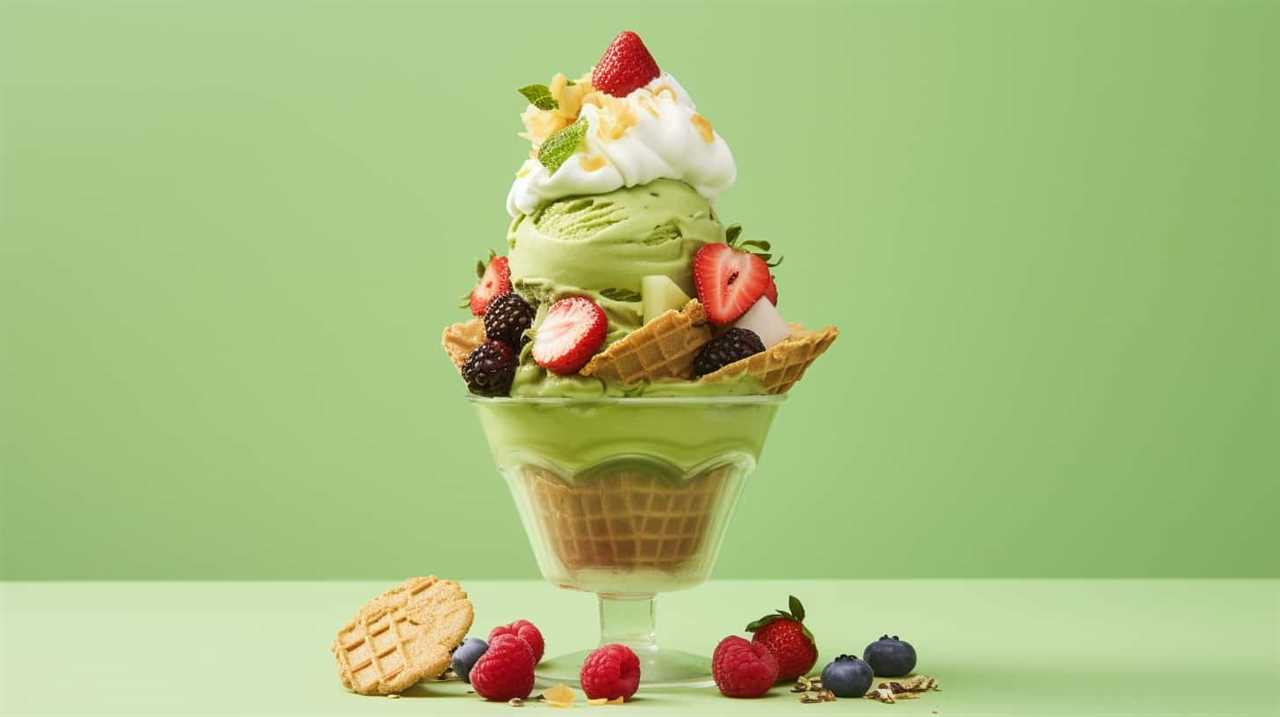
Anti-Aging Benefits of Matcha
One significant benefit of matcha for our skin is its ability to combat the signs of aging. Matcha contains a high concentration of antioxidants, which help to protect our skin from free radicals and oxidative stress, both of which contribute to the aging process. These antioxidants, such as catechins and polyphenols, work to neutralize the damage caused by free radicals, reducing the appearance of wrinkles and fine lines.
To fully harness the anti-aging benefits of matcha, it’s important to choose the right products and prepare them correctly. Look for matcha skincare products that contain high-quality, ceremonial grade matcha powder. This ensures that you’re getting the most potent and effective form of matcha for your skin.
Additionally, pay attention to the preparation methods. Matcha can be used in various ways, such as in face masks, creams, or even as a tea rinse. Experiment to find the method that works best for you, and enjoy the youthful benefits of matcha for your skin.
Matcha for Acne and Blemish Control
How can matcha help control acne and blemishes?
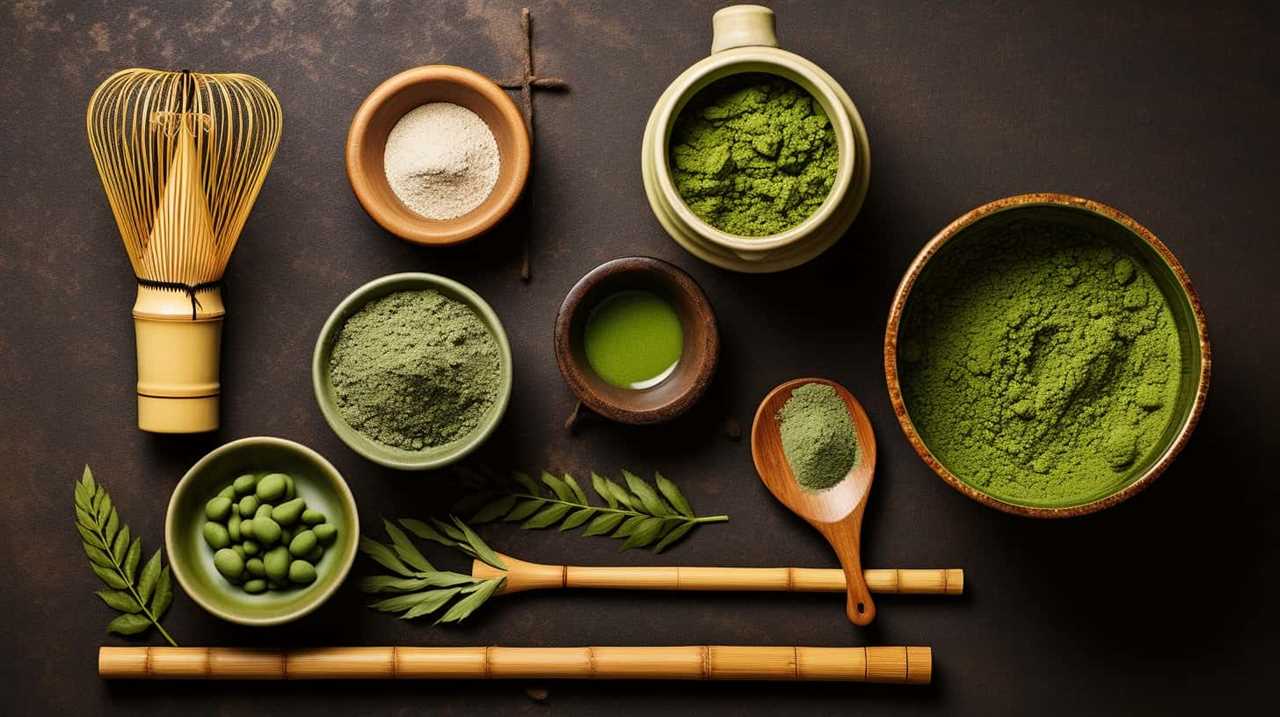
Matcha contains powerful antioxidants that can help reduce inflammation and fight the bacteria that contribute to acne breakouts. Here are three ways matcha can be beneficial for acne and blemish control:
- Matcha for scar healing: The antioxidants in matcha help promote cell regeneration, which can aid in fading acne scars and hyperpigmentation. By regularly incorporating matcha into your skincare routine, you may notice a reduction in the appearance of scars over time.
- Matcha for oil control: Matcha has the ability to regulate sebum production, which is essential for controlling excess oil on the skin. By keeping oil production in check, matcha can help prevent clogged pores and reduce the likelihood of developing acne.
- Matcha as an anti-inflammatory: Acne is often accompanied by redness and inflammation. Matcha’s anti-inflammatory properties can help soothe irritated skin and calm acne flare-ups, resulting in a clearer complexion.
With its scar healing and oil control properties, matcha can be a valuable addition to your acne-fighting skincare routine.
Transitioning into the next section, let’s explore the soothing and calming properties of matcha.
Soothing and Calming Properties of Matcha
One of the key benefits of matcha for skin care is its soothing and calming properties.
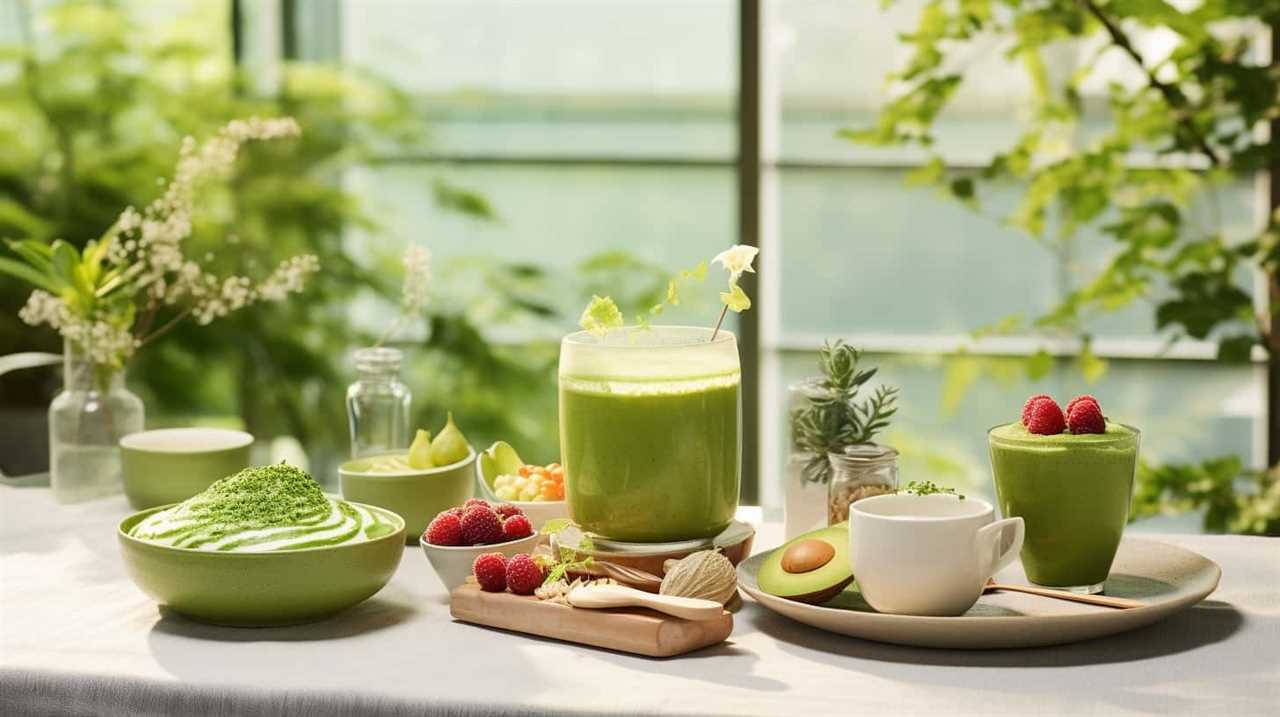
Matcha contains compounds that have anti-inflammatory effects, which can help reduce redness and irritation on the skin.
These properties make matcha an excellent ingredient for those with sensitive or reactive skin, as it can provide relief and promote a more balanced complexion.
Anti-Inflammatory Effects of Matcha
Matcha possesses remarkable anti-inflammatory properties, making it an excellent ingredient for soothing and calming the skin. Here are three reasons why matcha is beneficial for those with sensitive skin:
- Reduces redness and irritation: Matcha contains catechins, which are powerful antioxidants that help to reduce inflammation. These catechins have been shown to calm redness and soothe irritated skin, making matcha an ideal choice for those with sensitive skin.
- Calms acne and breakouts: Matcha’s anti-inflammatory properties also make it effective in calming acne and breakouts. By reducing inflammation, matcha can help to minimize the appearance of pimples and prevent future breakouts, leaving the skin clearer and smoother.
- Protects against UV damage: Matcha is rich in polyphenols, which have been found to have photoprotective properties. These polyphenols can help to protect the skin from harmful UV radiation and prevent sunburn, making matcha an excellent addition to your skincare routine for sensitive skin.
Incorporating matcha into your skincare regimen can help to soothe and calm sensitive skin, providing relief from redness, irritation, and acne. Its anti-inflammatory effects make it a valuable ingredient for those seeking a natural and effective solution for their skincare concerns.

Reduces Redness and Irritation
To experience the soothing and calming properties of matcha, incorporating this ingredient into our skincare routine can help reduce redness and irritation.
Matcha contains a high concentration of polyphenols, which have been shown to possess anti-inflammatory properties. These polyphenols help to calm the skin and reduce redness and irritation caused by environmental stressors or skin conditions such as rosacea or acne.
Matcha also contains EGCG (epigallocatechin gallate), a potent antioxidant that helps to protect the skin from free radicals and soothe any inflammation. Additionally, matcha has natural astringent properties, which can help to tighten pores and reduce redness.
When applied topically, the catechins found in matcha can penetrate the skin and provide a soothing sensation, helping to alleviate discomfort and promote a more balanced complexion.

Matcha for Brightening and Evening Out Skin Tone
Our experience with matcha has shown its effectiveness in brightening and evening out our skin tone. Matcha tea benefits our skin in various ways, and one of its standout qualities is its ability to promote a more even complexion.
Here are three reasons why matcha is a great option for brightening and evening out skin tone:
- Antioxidant-rich: Matcha is packed with antioxidants, such as catechins, which help fight free radicals that contribute to skin discoloration. These antioxidants help reduce the appearance of dark spots and hyperpigmentation, resulting in a more even skin tone.
- Detoxifying properties: Matcha has detoxifying properties that help remove impurities and toxins from the skin, leaving it refreshed and revitalized. This detoxification process helps to even out the skin tone by reducing dullness and promoting a healthy glow.
- Gentle exfoliation: Matcha face masks provide gentle exfoliation, removing dead skin cells and revealing a smoother, brighter complexion. This exfoliation helps to fade acne scars, sunspots, and other skin imperfections, resulting in a more even skin tone over time.
Hydrating and Moisturizing Effects of Matcha
When it comes to hydration, matcha offers a multitude of benefits for the skin. Its high content of catechins, a type of antioxidant, helps to replenish and lock in moisture, resulting in a more hydrated and plump complexion.
Additionally, matcha contains natural moisturizing properties that help to nourish and soothe the skin, leaving it feeling soft and supple.

These hydrating effects of matcha also contribute to its anti-aging properties, as well-hydrated skin tends to appear more youthful and radiant.
Skin Hydration Benefits
One of the key benefits of matcha for skin care is its ability to effectively hydrate and moisturize the skin. Matcha contains natural compounds that help to retain moisture and promote a healthy, dewy complexion.
Here are three ways matcha can benefit your skin hydration:
- Skin plumping: Matcha is rich in antioxidants that help to protect the skin from free radicals and environmental damage. This, in turn, helps to plump up the skin and reduce the appearance of fine lines and wrinkles.
- Increased moisture retention: Matcha has the ability to penetrate deep into the skin and lock in moisture, keeping it hydrated for longer periods. This helps to prevent dryness and flakiness, leaving your skin feeling soft and supple.
- Soothing and calming effects: Matcha has anti-inflammatory properties that can help to soothe irritated and inflamed skin. It can also reduce redness and promote a more even skin tone, giving you a healthier and more radiant complexion.
Natural Moisturizing Properties
Matcha provides a multitude of natural moisturizing properties that effectively hydrate and moisturize the skin. Its high content of antioxidants and amino acids help to nourish and protect the skin from environmental damage, keeping it hydrated and supple.

When used in a natural skincare routine, matcha can be incorporated into DIY face masks for a moisturizing boost. A simple DIY matcha face mask can be made by mixing matcha powder with honey or yogurt to create a thick paste. Apply the mask to your face, leave it on for 15-20 minutes, and then rinse off with warm water. This mask will provide deep hydration, leaving your skin feeling refreshed and rejuvenated.
Transitioning into the subsequent section about ‘anti-aging effects’, matcha’s moisturizing properties also contribute to its anti-aging benefits.
Anti-Aging Effects
The moisturizing properties of matcha contribute to its anti-aging effects, keeping our skin hydrated and youthful. Matcha is rich in antioxidants that help protect the skin against free radicals, which can lead to premature aging. Here are three ways matcha can help improve skin elasticity and reduce wrinkles:
- Hydration: Matcha contains natural oils that help lock in moisture, keeping the skin hydrated and plump. This helps improve skin elasticity, making it appear firmer and more youthful.
- Antioxidant Power: The high concentration of antioxidants in matcha helps fight off environmental damage and reduce the appearance of wrinkles. These antioxidants neutralize free radicals, preventing them from causing damage to the skin cells.
- Anti-Inflammatory Properties: Matcha has anti-inflammatory properties that can soothe and calm the skin. This helps reduce redness and inflammation, making the skin look smoother and more even-toned.
With its hydrating and moisturizing effects, matcha is an excellent addition to any anti-aging skincare routine.

Now, let’s explore how matcha can also act as a natural detoxifier for the skin.
Matcha as a Natural Detoxifier for the Skin
As we delve into the benefits of matcha for skin care, it becomes evident that incorporating matcha into our skincare routine can serve as a natural detoxifier for our skin. Matcha is packed with antioxidants that help to remove toxins and impurities from the skin, promoting a healthier complexion.
The natural remedies found in matcha work to stimulate the detoxification process, aiding in the elimination of harmful substances that can clog pores and lead to breakouts. By incorporating matcha into our skincare routine, we can harness its detoxifying properties to deeply cleanse our skin and improve its overall health.
Regular use of matcha-based products can help to restore balance and radiance to the skin, leaving it refreshed and rejuvenated.

Matcha for Reducing Inflammation and Irritation
Incorporating matcha into our skincare routine can also help to reduce inflammation and irritation, providing a soothing and calming effect on the skin.
Here are three key reasons why matcha is beneficial for reducing redness and promoting a healthier complexion:
- Anti-inflammatory properties: Matcha is rich in antioxidants called catechins, which have potent anti-inflammatory effects. These antioxidants help to calm irritated skin and reduce redness, making matcha an excellent choice for those with sensitive or reactive skin.
- Soothes and calms the skin: Matcha contains amino acids, such as L-theanine, which are known for their calming properties. When applied topically, matcha can help to soothe the skin, relieving any discomfort or irritation.
- Provides hydration: Matcha is also a great source of hydration for the skin. Its natural moisturizing properties help to replenish and nourish the skin, leaving it feeling soft and supple.
The Role of Matcha in Protecting Against Sun Damage
Using matcha can help protect against sun damage by providing natural sun protection and reducing the harmful effects of UV radiation. Matcha is rich in protective antioxidants, such as catechins and polyphenols, which have been shown to have a photoprotective effect on the skin. These antioxidants help to neutralize free radicals generated by UV radiation, preventing oxidative stress and DNA damage. Matcha also contains EGCG (epigallocatechin gallate), a powerful compound that has been found to reduce inflammation and protect against sunburn. Additionally, matcha can enhance the efficacy of sunscreen when applied topically, further boosting its sun protection benefits. Incorporating matcha into your skincare routine can provide an extra layer of defense against the damaging effects of the sun, keeping your skin healthy and radiant.
| Benefits of Matcha for Sun Protection | |
|---|---|
| Natural Sun Protection | Reduces UV damage |
| Rich in antioxidants | Prevents oxidative stress |
| Contains EGCG | Reduces inflammation |
| Enhances sunscreen efficacy | Boosts sun protection benefits |
Incorporating Matcha Into Your Skin Care Routine
Let’s explore how we can incorporate matcha into our skin care routine. Matcha, with its powerful antioxidants and soothing properties, can provide numerous benefits for our skin. Here are three ways to incorporate matcha into our daily skin care regimen:

- Matcha facial masks: Create a homemade facial mask by mixing matcha powder with ingredients like honey, yogurt, or aloe vera gel. Apply the mask to your face, leave it on for 10-15 minutes, and rinse off with warm water. This will help to nourish and detoxify your skin, leaving it refreshed and rejuvenated.
- Matcha infused skincare products: Look for skincare products that contain matcha as an ingredient. From cleansers to moisturizers, there are various matcha-infused options available in the market. These products can help to protect your skin from environmental damage, reduce inflammation, and improve overall skin health.
- Matcha face mists: Prepare a refreshing face mist by mixing matcha powder with distilled water in a spray bottle. Spritz it on your face throughout the day to hydrate and revitalize your skin. The antioxidants in matcha will help to combat free radicals and keep your skin looking radiant.
Incorporating matcha into our skin care routine can provide us with a natural and effective way to enhance our skin’s health and appearance.
Frequently Asked Questions
Can Matcha Be Used on All Skin Types?
Matcha can be used on all skin types. It has numerous benefits for acne prone skin, such as its anti-inflammatory and antioxidant properties. To incorporate matcha into your skincare routine, consider using matcha-infused products or making your own DIY masks.
Is Matcha Safe to Use During Pregnancy?
Using matcha during pregnancy can have benefits for pregnant women, such as providing antioxidants and supporting overall health. However, it is important to consult with a healthcare professional as there may be potential risks associated with consuming matcha during pregnancy.
Can Matcha Help With Reducing the Appearance of Dark Circles Under the Eyes?
Matcha has been shown to have antioxidant properties that can help reduce the appearance of dark circles under the eyes. Additionally, it has benefits for acne treatment and promoting hair growth.

Is It Necessary to Use Organic Matcha for Skin Care?
Using organic matcha for skin care is not necessary, but it does have its benefits. Matcha can be incorporated into your skincare routine in various ways, providing antioxidants, reducing inflammation, and promoting healthy skin.
Can Matcha Be Used as a Natural Remedy for Eczema or Psoriasis?
Matcha can be a natural remedy for eczema or psoriasis due to its anti-inflammatory properties. It can help soothe irritated skin and promote healing. Additionally, matcha is known for its benefits in acne treatment and anti-aging skincare routines.
Conclusion
In conclusion, matcha isn’t only a delicious beverage but also a powerful ingredient for skin care. With its high concentration of antioxidants, matcha can help fight signs of aging, control acne and blemishes, detoxify the skin, reduce inflammation and irritation, and protect against sun damage.
Adding matcha to your skin care routine is a natural and effective way to achieve healthy, radiant skin. Don’t miss out on the incredible benefits matcha has to offer for your skin.
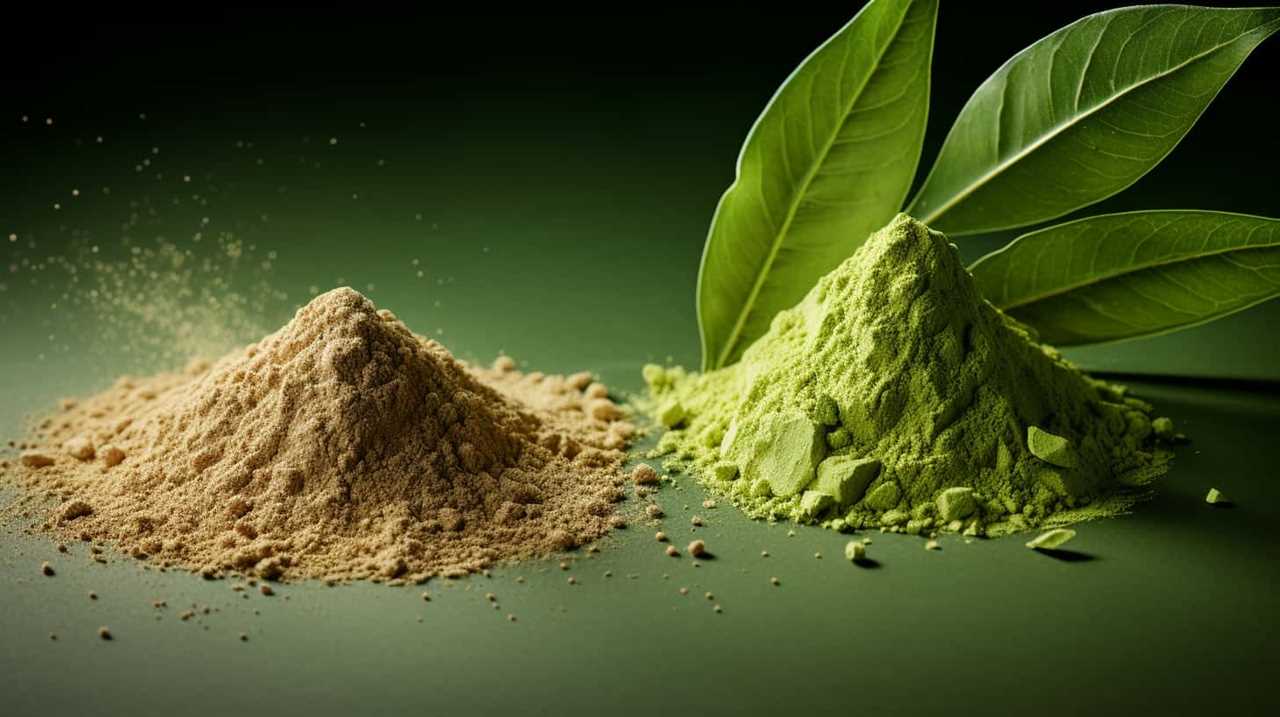
Justin is a seasoned author, coffee and tea enthusiast, and an essential member of the Cappuccino Oracle team. With a keen appreciation for the complexities of coffee, coffee alternatives, and tea, Justin has dedicated his professional career to exploring these realms and sharing his insights with readers worldwide.
Justin’s immersion in the world of coffee, coffee alternatives, and tea began at a young age, kindling a passion that extended beyond mere consumption. This love for these beverages led him to combine his talent for writing with his devotion to coffee and tea, bringing him to Cappuccino Oracle as a dedicated author.
Matcha
Unveiling The Mysteries Of Matcha: Insights On Its Origins, Production, And Quality

Have you ever been curious about the mysteries behind the rich and natural flavors of matcha? If so, get ready to join me on an adventure as we uncover the secrets of matcha, delving into its origins, production, and quality.
As a lover of all things tea, I have delved deep into the world of matcha, immersing myself in its rich history and intricate production process. From the shade-grown tea leaves to the meticulous grinding technique, every step is a labor of love that culminates in the velvety smooth powder we know as matcha.
Join me as we unravel the secrets behind this ancient Japanese tradition and discover why quality is key when indulging in this verdant elixir. We’ll explore the nuances of flavor, the importance of sourcing, and even delve into the fascinating world of other tea varieties.
So grab a cup, sit back, and let’s dive into the captivating world of matcha.
Key Takeaways
- Matcha tea is made from powdered green tea leaves and has a long and labor-intensive production process.
- Premium matcha is made from the first harvest in early spring, using the top 3 sprouts of the tea plant and ground tencha leaves.
- Cheaper matchas may skip some steps in the production process and are more suitable for matcha lattes.
- High-quality matcha is recommended for sparing consumption, as it has a smoother flavor and more health benefits compared to cheaper matchas.
What is matcha?
I’ve learned that matcha is a powdered green tea made from special tea leaves that are shaded before harvest, and it has a long and labor-intensive production process.
There are different types of matcha available, but the premium matcha is made from the first harvest in early spring, using only the top 3 sprouts of the tea plant. The leaves are then steamed, dried, and have their stems removed before being ground into a fine powder using a specialized mill made of granite.
It’s important to note that high-quality matcha is recommended for sparing consumption, as it has a complex production process that results in a smooth flavor. Matcha also offers various health benefits, such as being rich in antioxidants, boosting metabolism, and improving mental alertness.
Production process
The matcha production process involves shading the tea leaves before harvest and selecting the top three sprouts of the tea plant for premium matcha. Shading is a technique used to enhance the flavor and quality of the tea leaves. By covering the tea plants with shade, the leaves produce more chlorophyll and amino acids, resulting in a vibrant green color and a rich, umami taste.
After the shading period, only the top three sprouts of the tea plant are carefully handpicked for premium matcha. These selected leaves, known as tencha leaves, are then steamed, dried, and have their stems removed.
Finally, the tencha leaves are ground into a fine powder using a specialized granite mill. This process results in the smooth and concentrated matcha powder that we enjoy.
Quality and consumption
Let me tell you, indulging in high-quality matcha is like sipping a vibrant green elixir that awakens your taste buds and nourishes your body with its rich flavor and numerous health benefits. Matcha’s health benefits are truly remarkable. Packed with antioxidants, vitamins, and minerals, matcha is known to boost metabolism, enhance focus and concentration, and strengthen the immune system.
But not all matcha is created equal. Different grades of matcha exist, ranging from ceremonial grade to culinary grade. Ceremonial grade matcha is made from the highest quality tencha leaves and has a smooth, vibrant green color and a delicate, umami flavor. It is best enjoyed on its own, whisked with hot water.
On the other hand, culinary grade matcha is more affordable and is suitable for making matcha lattes, smoothies, and baked goods. Although it may have a slightly bitter taste and a duller color, it still provides health benefits.
So, whether you choose to indulge in high-quality ceremonial grade matcha or opt for the more affordable culinary grade, incorporating matcha into your routine is a delicious way to reap its health benefits.
Frequently Asked Questions
What are some popular ways to enjoy matcha besides drinking it as tea?
Besides drinking matcha as tea, some popular ways to enjoy it include indulging in matcha desserts like matcha ice cream, matcha cake, and matcha cookies. Additionally, matcha smoothies are a refreshing and healthy option.
Are there any specific health benefits associated with consuming matcha?
I’m no expert, but matcha is said to have potential health benefits. Some claim it can aid in weight loss due to its high antioxidant content and metabolism-boosting properties. However, more research is needed to confirm these claims.
How does the quality of matcha affect its flavor and overall experience?
The quality of matcha directly affects its flavor and overall experience. Higher quality matcha, made from carefully selected leaves and processed with precision, offers a smoother and more vibrant flavor, while lower quality matcha may have a less appealing taste and color.
Can matcha be used in cooking or baking?
"Where there’s matcha, there’s a way! Matcha can be used in a variety of cooking and baking recipes, adding a vibrant green color and a unique earthy flavor to dishes like matcha desserts."
Are there any specific tips or techniques for properly preparing matcha tea at home?
To properly prepare matcha tea at home, start by sifting the matcha powder to remove any clumps. Then, choose water at around 175°F to 180°F for the best flavor. Gradually add water to the matcha and whisk in a "W" or "M" motion until frothy. Enjoy!
Conclusion
In conclusion, matcha tea is not just a beverage, but a rich and fascinating tradition that has evolved over centuries.
From its origins in Japan to its intricate production process, matcha is a labor of love.
The quality of matcha is crucial, as the steps taken in its production directly impact its flavor and aroma.
Whether you’re a matcha connoisseur or a beginner, there is a matcha tea out there for you.
So, why not indulge in a cup of this vibrant green elixir and experience the magic of matcha for yourself? It’s a journey worth embarking on!
Arf, an author and an innovative enthusiast of coffee, coffee alternatives, and tea, plays a crucial role as a contributor to the esteemed Cappuccino Oracle platform. Renowned for his curiosity and passion for these captivating beverages, Arf has carved out a unique space for himself in the world of exploration and writing. He realized that coffee, coffee alternatives, and tea are not mere drinks to keep one awake, but universes of flavors and stories waiting to be explored.
Arf’s articles for Cappuccino Oracle blend meticulous research with personal experiences, providing readers with an in-depth understanding of various types of coffee, coffee alternatives, and tea, along with their unique characteristics, cultures, and histories. His honest reviews and engaging narratives guide readers on their own journeys, helping them discover their preferences and find their perfect brew.
Matcha
Unveiling The Truth Behind Starbucks’ Matcha: A Disappointing Blend

Being a lover of tea, I was eager to sample Starbucks’ matcha beverages, anticipating a flavorful and genuine taste. However, to my dismay, I found that it was a subpar mixture of inexpensive green tea powder and an excessive amount of sugar. This was a stark contrast to the customary matcha experience that I had grown accustomed to.
The use of low-quality matcha by Starbucks is driven by the need for mass production and a consistent taste across all locations. But in this pursuit, they have sacrificed the true essence of matcha. Authentic matcha production involves meticulous steps to ensure a high-quality and flavorful product, steps that Starbucks seems to skip.
The result is a matcha latte packed with 32 grams of sugar, equivalent to a can of soda, and a whopping 240 calories. It’s time to unveil the truth behind Starbucks’ matcha and explore better options for a truly satisfying tea experience.
Key Takeaways
- Starbucks uses a cheap green tea powder for their matcha drinks, which may not even be considered matcha.
- The cheap matcha powder is mixed with a lot of sugar, negating the health benefits and undermining the quality of the tea.
- Starbucks’ matcha latte contains a high amount of sugar, similar to a can of soda, and has a significant number of calories.
- To have a better matcha experience, it is recommended to explore premium, first harvest matcha made by talented farmers in Japan and to try different matcha options to find preferred taste.
What is Starbucks Matcha?
Starbucks Matcha is a cheap green tea powder mixed with a high amount of sugar, which not only undermines the health benefits of matcha but also fails to deliver the natural, great-tasting flavor of authentic matcha tea.
The ingredients used in Starbucks matcha include low-quality green tea powder that is likely produced on a large scale. Unlike traditional matcha production methods, Starbucks skips certain steps to save time and money. These steps, such as shading the tea plants to reduce bitterness and selecting the top leaves for their flavor and nutrients, are crucial in creating high-quality matcha.
Instead, Starbucks opts for a blend of cheap green tea powder mixed with sugar, resulting in a dull and bitter flavor. This disappointing blend of ingredients does not live up to the standards of true matcha tea.
Quality vs. Cheap Matcha
Indulging in high-quality matcha is like savoring a delicate melody that dances on your taste buds, while settling for cheap matcha is akin to a discordant symphony that leaves a bitter aftertaste. When it comes to matcha, quality matters. Traditional matcha production is an art that requires time, patience, and attention to detail. The importance of shading the tea plants, selecting the top leaves, and using a stone mill to grind the leaves into a fine powder cannot be overstated. These steps not only enhance the flavor but also preserve the health benefits of matcha. High-quality matcha is rich in antioxidants, boosts metabolism, and promotes a sense of calm. On the other hand, cheap matcha often lacks these qualities as it skips crucial steps and is mixed with sugar and other additives. Don’t settle for a subpar matcha experience; choose high-quality matcha for its exceptional taste and health benefits.
| Traditional Matcha Production |
|---|
| Shading the tea plants |
| Selecting the top leaves |
| Grinding with a stone mill |
The importance of traditional matcha production cannot be overstated. These steps not only enhance the flavor but also preserve the health benefits of matcha. High-quality matcha is rich in antioxidants, boosts metabolism, and promotes a sense of calm. On the other hand, cheap matcha often lacks these qualities as it skips crucial steps and is mixed with sugar and other additives. Don’t settle for a subpar matcha experience; choose high-quality matcha for its exceptional taste and health benefits.
Recommendations for Better Matcha
Exploring different matcha options can lead to a better matcha experience. When it comes to matcha, not all options are created equal. While Starbucks may offer a convenient matcha latte, there are alternative options that provide a more authentic and higher quality experience.
Premium matcha, specifically first harvest matcha, is made by talented farmers in Japan and can be enjoyed plain, without the need for excessive sugar or additives. By choosing premium matcha, you can reap the full benefits that matcha has to offer, such as its high antioxidant content and potential health benefits.
Additionally, exploring different types of matcha, such as Japanese black tea, can expand your taste palate and introduce you to new and exciting flavors. So, why settle for a disappointing blend when there are better matcha options out there waiting to be explored?
Frequently Asked Questions
How is Starbucks matcha different from traditional matcha?
Starbucks matcha differs from traditional matcha in terms of quality and taste. One interesting statistic is that Starbucks’ matcha latte contains 32 grams of sugar, similar to a can of soda, which undermines the health benefits of matcha.
What are the health benefits of matcha and how do they differ between Starbucks matcha and premium matcha?
The health benefits of matcha include high levels of antioxidants, increased energy, and improved focus. However, Starbucks matcha quality is compromised due to the use of cheap powder mixed with sugar, negating these benefits.
Can you customize the sweetness level of Starbucks matcha drinks?
Yes, you can customize the sweetness level of Starbucks matcha drinks. They offer popular matcha drink variations like matcha latte and matcha frappuccino, allowing customers to choose the amount of sweetener they prefer.
Are there any alternative options for matcha drinks at Starbucks?
Yes, there are alternative options for matcha drinks at Starbucks. However, it’s important to note that the taste may not be comparable to traditional matcha. Exploring different matcha options and Japanese black tea can provide a better experience.
What are the steps involved in producing high-quality matcha and how does Starbucks’ matcha production differ?
Starbucks’ matcha production process differs from traditional matcha production in Japan. High-quality matcha involves shading the tea plants, selecting the top leaves, steaming, drying, and grinding them. However, Starbucks skips these steps, resulting in a lower quality and less authentic matcha experience.
Conclusion
In conclusion, after delving into the truth behind Starbucks’ matcha, it’s clear that their blend falls short of expectations. The use of cheap green tea powder mixed with excessive sugar dilutes any potential health benefits and fails to deliver an authentic matcha experience.
To truly enjoy the rich and flavorful taste of matcha, it’s recommended to explore premium, first harvest options crafted by skilled Japanese farmers. Don’t settle for subpar matcha; treat yourself to a tea experience that’ll leave your taste buds dancing with delight.
Arf, an author and an innovative enthusiast of coffee, coffee alternatives, and tea, plays a crucial role as a contributor to the esteemed Cappuccino Oracle platform. Renowned for his curiosity and passion for these captivating beverages, Arf has carved out a unique space for himself in the world of exploration and writing. He realized that coffee, coffee alternatives, and tea are not mere drinks to keep one awake, but universes of flavors and stories waiting to be explored.
Arf’s articles for Cappuccino Oracle blend meticulous research with personal experiences, providing readers with an in-depth understanding of various types of coffee, coffee alternatives, and tea, along with their unique characteristics, cultures, and histories. His honest reviews and engaging narratives guide readers on their own journeys, helping them discover their preferences and find their perfect brew.
Matcha
The Ultimate Guide To Using Chashaku: Your Matcha Essential

Being a lover of matcha, I am aware that the crucial factor in achieving the perfect matcha bowl is the equipment we utilize. When it comes to preparing matcha, there is one tool that is particularly essential: the chashaku.
This bamboo spoon, with its elegant design and precise measurements, is the secret weapon of matcha lovers worldwide. In this ultimate guide, I will take you on a journey through the history and evolution of the chashaku, and show you how to use it like a pro.
From its origins as a metal or ivory scoop to its modern-day incarnation in bamboo, the chashaku has come a long way. With its 48° bend and 18mm length, it effortlessly scoops the perfect amount of matcha from its container.
So grab your chashaku and get ready to elevate your matcha game to new heights. Let’s dive in and discover the wonders of this matcha essential.
Key Takeaways
- Chashaku is a bamboo spoon used to scoop matcha powder in the Japanese tea ceremony and by matcha lovers worldwide.
- Chashaku is one of the three important tea utensils used in the tea ceremony and is about 18mm in length with a 48° bend at the end for scooping.
- Chashaku is made of bamboo to avoid negative reactions with matcha powder and is a great measurement tool for matcha powder.
- Two scoops of chashaku is the standard amount for a bowl of matcha tea, and it is easy to maneuver in matcha tins or natsume due to its small size.
What is Chashaku?
Chashaku is a bamboo spoon used to scoop matcha powder, and it’s one of the three important tea utensils used in the Japanese tea ceremony.
Made from a single piece of bamboo, this elegant tool has a long history dating back to the Muromachi period in Japan. Originally crafted from metal or ivory, chashaku evolved to be made of bamboo due to its natural properties and to avoid any negative reactions with matcha powder.
The design of chashaku is both functional and beautiful, with a length of about 18mm and a 48° bend at the end for easy scooping. There are different styles of chashaku scoops, each with its own unique shape and characteristics. The back of the chashaku has a rough texture, while the face is smooth and sleek.
Whether you’re a matcha lover or a tea ceremony enthusiast, using a chashaku adds a touch of authenticity and tradition to your matcha preparation.
History and Evolution
During the Muromachi period in Japan, the chashaku spoon evolved from being made of metal or ivory to its current bamboo form, which is about 18mm in length and has a 48° bend at the end for easier scooping. The history and evolution of the chashaku is a testament to its significance in Japanese tea ceremonies and its cultural importance in matcha preparation.
| The significance of chashaku in Japanese tea ceremonies | The cultural importance of chashaku in matcha preparation |
|---|---|
| Chashaku is one of the three important tea utensils used in the tea ceremony. | Chashaku is a great measurement tool for matcha powder. |
| Chashaku originated in Japan during the Muromachi period. | Chashaku’s small size allows for easy maneuvering in matcha tins or natsume. |
| Originally made of metal or ivory, chashaku evolved to be made of bamboo. | Chashaku is made from a single piece of bamboo and shaped with a bend for the scoop. |
| Chashaku is made of bamboo to avoid negative reactions with matcha powder. | The back of chashaku has a rough texture, while the face is smooth and sleek. |
The chashaku’s role in Japanese tea ceremonies cannot be understated. It is one of the three essential utensils used in the tea ceremony, alongside the chawan (tea bowl) and chasen (tea whisk). The chashaku’s small size and precise measurement make it the perfect tool for scooping matcha powder. Its evolution from metal or ivory to bamboo shows the cultural importance placed on this utensil. The chashaku’s design, with its gentle bend and smooth face, allows for easy and graceful scooping of matcha. Using the chashaku is not only practical but also a way to honor the centuries-old tradition of matcha preparation.
How to Use Chashaku
To use the chashaku, I simply hold it like a pencil and dip the scoop into the matcha container. Then, I carefully lift the chashaku scoop out and place it over the matcha bowl to dump the powder.
It’s a simple and elegant technique that ensures the perfect amount of matcha every time.
But did you know that there are alternative ways to use the chashaku? Some matcha lovers prefer to use a teaspoon or a regular spoon to scoop their matcha powder. While these alternatives may work in a pinch, they don’t offer the same precision and authenticity as the chashaku.
The chashaku’s unique design and size make it the ideal tool for measuring matcha powder. Plus, using the chashaku adds a traditional touch to the matcha preparation process, enhancing the overall experience.
So why settle for anything less? Embrace the chashaku and elevate your matcha game to the next level.
Frequently Asked Questions
What are the different types of materials used to make chashaku besides bamboo?
There’s something truly magical about the chashaku, the bamboo spoon that gracefully scoops matcha powder. While bamboo is the traditional material, chashaku can also be made from metal or ivory, although these alternatives are less common.
Can chashaku be used to scoop other powders besides matcha?
Yes, chashaku can be used to scoop other powders besides matcha. However, it is primarily designed for scooping matcha powder and is most commonly used in Japanese tea ceremonies. To properly clean and care for a chashaku, it is recommended to wipe it with a dry towel or tissue to avoid water damage. The chashaku is a versatile tool with different uses in the tea ceremony, making it an essential item for matcha lovers.
How long does a chashaku typically last before it needs to be replaced?
A chashaku typically lasts for a long time, but the lifespan can vary depending on the material. Bamboo chashaku is the most common and durable option, while metal or ivory may wear down over time. Proper care involves cleaning with a dry towel or tissue to avoid water damage.
Can chashaku be used with different types of matcha bowls or is it specific to a certain style?
Absolutely! Chashaku can be used with various types of matcha bowls, adapting to different styles. Its small size and unique design make it perfect for scooping matcha powder and adding a touch of elegance to your matcha preparation.
Are there any alternative utensils that can be used in place of chashaku for scooping matcha powder?
Yes, there are alternative utensils for scooping matcha powder, such as a teaspoon or a small spoon. However, using a chashaku has its benefits. Its unique design allows for precise measurements and easy maneuvering in matcha tins.
Conclusion
In conclusion, using chashaku isn’t just a practical way to measure and scoop matcha powder, but it’s also an essential tool for embracing the art and tradition of the Japanese tea ceremony.
While some may argue that using a regular spoon can achieve the same result, chashaku offers a unique experience that connects us to centuries of tea culture. Imagine holding the slender bamboo spoon, feeling the weight of tradition in your hand, and delicately scooping the vibrant green matcha powder.
It’s a sensory journey that brings us closer to the beauty and mindfulness of matcha preparation. So, embrace the chashaku, and let it elevate your matcha experience to new heights.
Arf, an author and an innovative enthusiast of coffee, coffee alternatives, and tea, plays a crucial role as a contributor to the esteemed Cappuccino Oracle platform. Renowned for his curiosity and passion for these captivating beverages, Arf has carved out a unique space for himself in the world of exploration and writing. He realized that coffee, coffee alternatives, and tea are not mere drinks to keep one awake, but universes of flavors and stories waiting to be explored.
Arf’s articles for Cappuccino Oracle blend meticulous research with personal experiences, providing readers with an in-depth understanding of various types of coffee, coffee alternatives, and tea, along with their unique characteristics, cultures, and histories. His honest reviews and engaging narratives guide readers on their own journeys, helping them discover their preferences and find their perfect brew.
-

 Americano3 weeks ago
Americano3 weeks agoHow to Make Americano With Moka Pot
-

 Americano4 weeks ago
Americano4 weeks agoHow to Make an Americano in a French Press
-

 Americano6 days ago
Americano6 days agoHow to Make Korean Iced Americano
-

 Americano3 weeks ago
Americano3 weeks agoHow to Make Iced Americano With Instant Coffee
-

 Americano3 weeks ago
Americano3 weeks agoWhat to Add to an Americano at Starbucks
-

 Americano4 weeks ago
Americano4 weeks agoHow to Make Americano With a Nespresso Machine
-

 Americano3 weeks ago
Americano3 weeks agoHow to Make Americano With Bialetti
-

 Americano3 weeks ago
Americano3 weeks agoHow to Make Dutch Bros Americano









